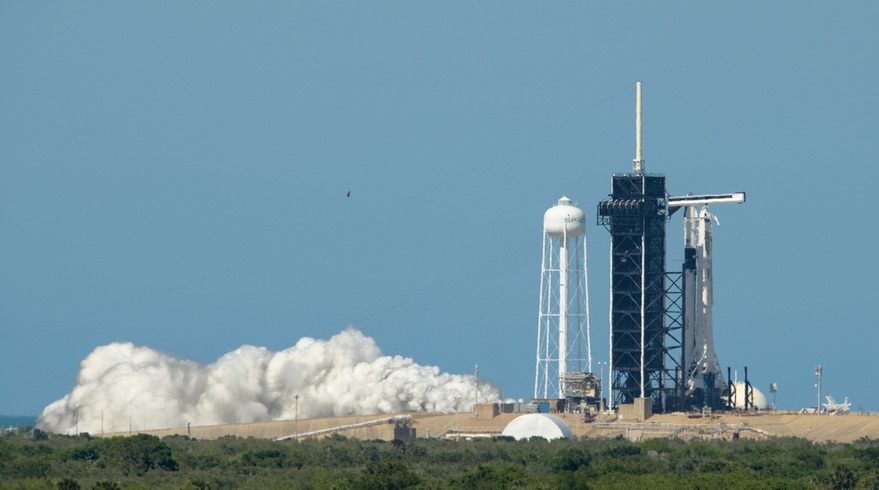WASHINGTON — NASA has given SpaceX approval to proceed with final preparations for the first commercial crew mission with astronauts on board, although there is still work to complete ahead of the planned May 27 launch.
NASA and SpaceX completed a flight readiness review (FRR) May 22 that lasted one and a half days. At the end of the review, agency leaders gave their approval to continue with plans for a May 27 launch of the SpaceX Crew Dragon spacecraft on the Demo-2 mission, with NASA astronauts Bob Behnken and Doug Hurley on board.
“We had a very successful flight readiness review, in that we did a thorough review of all of the systems and all the risks, and it was unanimous on the board that we are go for launch,” NASA Associate Administrator Steve Jurczyk, who led the review, said at a briefing at the Kennedy Space Center about an hour after its conclusion.
Jurczyk noted that the review ended with “no significant open issues” yet to resolve. “In the end it was a very, very clean review,” he said. However, there were extensive discussions on several topics.
“I think everybody in the room was very clear that now was the time to speak up if there are any challenges, and there were,” said NASA Administrator Jim Bridenstine. “There were conversations that were had that were very important to be had. But it’s also true that at the end, as each system and subsystem was considered, we got to a ‘go.’”
One example of such conversations was a review of the Crew Dragon parachute system, which suffered problems in its development leading to a new design that went through a rapid series of tests since last fall. “We took a long time in a couple of presentations during the review to have the team walk us through the design, the changes, the qualification testing and the margin on the chute to make sure that everybody was good,” Jurczyk said. “We had very high confidence that they will function as we need them to.”
Other “special topics” that got extended discussion at the FRR was an issue about compatibility of titanium valves with nitrogen tetroxide propellant in the SuperDraco thrusters on the spacecraft, a problem linked to the April 2019 explosion of a Crew Dragon spacecraft just before a static-fire test of those thrusters. NASA and SpaceX did “a tremendous amount of work” to mitigate those concerns, Jurczyk said.
There was also a more recent issue with spacecraft’s fire suppression system, which suffered from what he described as a “performance shortfall.” An analysis of that system concluded that there was a very low risk of a problem.
The completion of the FRR, though, does not mean the end of preparations for the launch. NASA and SpaceX will spend the coming days going through remaining “open work” ahead of the launch. That includes final checkouts of the spacecraft, said Kathy Lueders, NASA commercial crew program manager, as well as reviewing data. “We’ll be working Saturday, Sunday, Monday, Tuesday, up to launch day to make sure we’re still checking everything out,” she said.
Another prelaunch event took place shortly after the briefing, when SpaceX conducted its standard static-fire test of the Falcon 9 first stage engines. SpaceX confirmed two hours later that the test was a success.
On May 23, NASA and SpaceX will perform a “dry dress” rehearsal of launch preparations, including having Behnken and Hurley get into their pressure suits, travel to the launchpad and get into the Crew Dragon, but not fueling the rocket. That final rehearsal, she said, is intended to make sure “everything is working days before the launch.”
NASA also said the review confirmed that the agency’s partners in the International Space Station program had agreed to allow the Crew Dragon to dock with the station. That includes the Russian space agency Roscosmos, which had concerns last year about the uncrewed Demo-1 mission to the station.
Kirk Shireman, NASA ISS program manager, said SpaceX made an unspecified change to the spacecraft after the Demo-1 mission to fix a “very, very remote” possibility of a spacecraft failure that could damage the station. “Roscosmos participated and they were ‘go,’” he said.
The work, Lueders said, won’t stop with the Demo-2 launch itself, scheduled for 4:33 p.m. Eastern May 27. “Human spaceflight is really, really tough. It’s why we continue to look for risks,” she said. “We’re going to stay hungry until Bob and Doug come home.”
